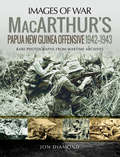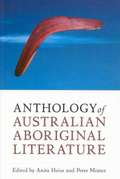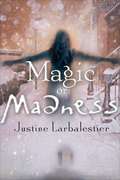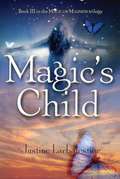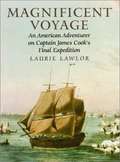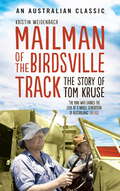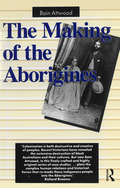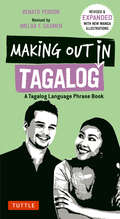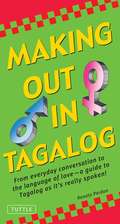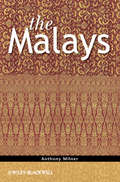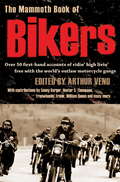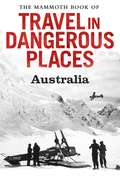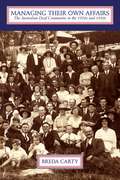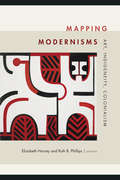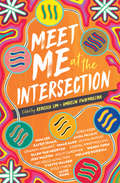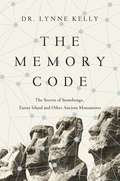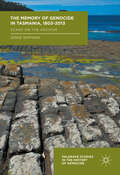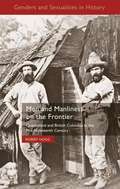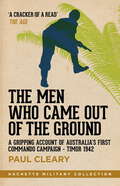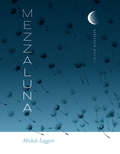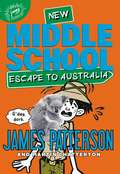- Table View
- List View
MacArthur's Papua New Guinea Offensive, 1942–1943 (Images of War)
by Jon Diamond Dr.&“A compelling chronicle of the Battle of Papua New Guinea with rarely viewed images from World War II . . . an excellent book.&” —Naval Historical Foundation The Japanese seizure of Rabaul on New Britain in January 1942 directly threatened Northern Australia and, as a result, General Douglas MacArthur took command of the Southwest Pacific Area. In July 1942, the Japanese attacked south across the Owen Stanley mountain range. Thanks to the hasty deployment of Australian militiamen and veteran Imperial Force troops the Japanese were halted at Ioribaiwa Ridge just 27 miles from Port Moresby. MacArthur&’s priority was to regain Northeast New Guinea and New Britain. The capture of airfields at Buna and reoccupation of Gona and Sanananda Point were prerequisites. The Allied offensive opened on 16 November 1942 with Australian infantrymen and light tanks alongside the US 32nd Infantry Division. Overcoming the Japanese and the inhospitable terrain in tropical conditions proved the toughest of challenges. It remains an achievement of the highest order that the campaign ended successfully on 22 January 1943. This account with its clear text and superb imagery is a worthy tribute to those who fought and, all too often, died there.&“Covers a seriously neglected key campaign of WWII. Most Highly Recommended.&” —Firetrench&“A fascinating look at real jungle warfare and the images only accentuate how miserable troops must have been during the fighting.&” —ModelingMadness.com
Macquarie Pen Anthology of Aboriginal Literature
by Peter Minter Anita HeissA groundbreaking collection of work from some of the great Australian Aboriginal writers, the MACQUARIE PEN ANTHOLOGY OF ABORIGINAL LITERATURE offers a rich panorama of over 200 years of Aboriginal culture, history and life. From Bennelong's 1796 letter to contemporary creative writers, Anita Heiss and Peter Minter have selected work that represents the range and depth of Aboriginal writing in English. The anthology includes journalism, petitions and political letters from both the nineteenth and twentieth centuries, as well as major works that reflect the blossoming of Aboriginal poetry, prose and drama from the mid-twentieth century onwards. Literature has been used as a powerful political tool by Aboriginal people in a political system which renders them largely voiceless. These works chronicle the ongoing suffering of dispossession, but also the resilience of Aboriginal people across the country, and the hope and joy in their lives. With some of the best, most distinctive writing produced in Australia, this anthology is invaluable for anyone interested in Aboriginal writing and culture.
Magic or Madness (Magic or Madness, Book #1)
by Justine LarbalestierReason has lived fifteen years in the Australian outback with her mother, Sarafina, They're on the run from Reason's grandmother Esmeralda, who believes in magic and practices horrifying dark rituals. But when Sarafina suffers a mental breakdown, Reason is sent to the one place she fears most--'Esmeralda's home in Sydney. Nothing about the house or Esmeralda is what Reason expected. For the first time she finds herself questioning her mother's teachings. Then, when she walks through Esmeralda's back door in Sydney and finds herself on a New York City street, Reason is forced to face the shocking truth. magic is real. And Reason is magic. The first book in Justine Larbalestier's thrilling trilogy brings readers from one country to another and through revelation upon revelation, leading to Reason's ultimate discovery of the price she must pay for the magic that lives in her blood.
Magic's Child (Magic or Madness #3)
by Justine LarbalestierIn the third installment in the Magic or Madness trilogy, the people Reason Cansino loves most are all in danger. Reason’s mother, Sarafina, has disappeared from the mental hospital in Sydney with Reason’s evil grandfather, Jason Blake. Jay-Tee, the closest thing Reason has to a best friend, has used all of her magic and faces death at any moment. Only Reason can find the answers within her family’s magic to save everyone who matters most to her.
Magnificent Voyage: An American Adventurer on Captain James Cook's Final Expedition
by Laurie LawlorWhen Captain James Cook set off on his third and final voyage in 1776, a crew of intrepid and perhaps naive men sailed with him, including a twenty-five-year-old American named John Ledyard. This riveting account based on Ledyard's journal brings dramatic events of that historic voyage to life, including the discovery of the Hawaiian Islands by Europeans, and the desperate attempts to find the Northwest Passage along the treacherous Alaskan coast. Maps, time line, biographies of the expedition's crew members, source notes, and index are included.
Mailman of the Birdsville Track: The story of Tom Kruse
by Kristin WeidenbachThe truly classic Australian story of Tom Kruse - legendary mailman of the Birdsville Track.For the people who lived in the desert between Marree and Birdsville, contact with the outside world was hard and sporadic - but one man was their lifeline: Tom Kruse. For more than twenty years he was the connection with the outside world for the families, station workers and others who lived along the Birdsville Track.Tom delivered everything from the mail and newspapers to fuel and food - whole communities waited in anticipation for him to drop off their supplies. But it was a hard life, from regularly making running repairs to his truck to unloading and reloading tons of stores so that he could ferry his cargo across flooded creeks. Come sandhills, hell or high water, Tom Kruse kept faith with the locals up and down the Track.Tom was a real Australian hero - and no matter what happened, the mail always got through.'Told with honesty and vigour' - Sydney Morning Herald'A tribute to a man who earned the love of a whole generation of Australians and shows us that the pioneer characteristics of guts and good-natured stoicism are still beautiful' - The Age'Full of characters' - Daily Telegraph
Mailman of the Birdsville Track: The story of Tom Kruse
by Kristin WeidenbachThe truly classic Australian story of Tom Kruse - legendary mailman of the Birdsville Track.For the people who lived in the desert between Marree and Birdsville, contact with the outside world was hard and sporadic - but one man was their lifeline: Tom Kruse. For more than twenty years he was the connection with the outside world for the families, station workers and others who lived along the Birdsville Track.Tom delivered everything from the mail and newspapers to fuel and food - whole communities waited in anticipation for him to drop off their supplies. But it was a hard life, from regularly making running repairs to his truck to unloading and reloading tons of stores so that he could ferry his cargo across flooded creeks. Come sandhills, hell or high water, Tom Kruse kept faith with the locals up and down the Track.Tom was a real Australian hero - and no matter what happened, the mail always got through.'Told with honesty and vigour' - Sydney Morning Herald'A tribute to a man who earned the love of a whole generation of Australians and shows us that the pioneer characteristics of guts and good-natured stoicism are still beautiful' - The Age'Full of characters' - Daily Telegraph
The Making of the Aborigines
by Bain AttwoodBefore 1788, the peoples of this continent did not consider themselves 'Aboriginal'. They only became 'Aborigines' in the wake of the British invasion. In this startling and original study, Bain Attwood reveals how relationships between black Australians and European colonisers determined the hearts and minds of the indigenous peoples, making them anew as Aboriginals.In examining the period after the 'killing times', this young historian provides new perspectives on racial ideology, government policy, and the rule of law. In examining European domination, he unravels the patterns of associations which were woven between European and Aborigine, and shows the complex meanings and significance these relationships held for both groups.In this book, the dispossessed are not cast as merely passive victims; they appear as real characters, men and women who adapted to European colonisation in accordance with their own historical and cultural experience. Out of this exchange the colonised created a new consciousness and began to forge a common identity for themselves.A story of cultural change and continuity both poignant and disturbing in its telling, this important book is sure to provoke controversy about what it means to be Aboriginal.'This intelligent and impeccably researched book seeks to advance our understanding of the story of white/Aboriginal contact. It will be required reading for anyone working in the field.' - Henry Reynolds'Colonisation is both destructive and creative of peoples. Recent historians have revealed the extensive destruction of black Australians and their cultures. But now Bain Attwood, in this finely crafted and highly original series of case studies. plots the complex human relations and historical forces that re-made these indigenous people into the Aborigines.' - Richard Broome
Making Out in Tagalog: A Tagalog Language Phrase Book
by Imelda F. Gasmen Renato PerdonMaking Out in Tagalog is your indispensable guide to contemporary Tagalog language (Filipino) as it's really spoken on the streets of Manila.This best-selling Tagalog phrase book is the perfect introduction to everyday interactions in The Philippines and other Tagalog-speaking countries, and includes colorful slang that'll help rev up your social life. A great way to learn Tagalog, Making Out in Tagalog features a pronunciation guide, and notes on Tagalog language and culture. With Making Out in Tagalog you'll be able to express yourself when: Making new friends Sharing a meal Going out on the town Flirting and getting amorous And much more!Each expression in this book is given in Tagalog and their English translations. It is designed to enhance your experience in using the language (and in a pinch, you can show the Tagalog text to the person you're speaking to). Making Out in Tagalog also includes interesting tips on social norms and cultural practices, eating, social media, hanging out, and other situations. For the savvy traveler, this is a Tagalog phrasebook you won't want to be without!
Making Out in Tagalog: (Tagalog Phrasebook)
by Renato PerdonMaking Out in Tagalog is a fun, accessible and thorough Tagalog phase book and guide to the Filipino language as it's really spoken.<P><P>If you are a student, businessman or tourist traveling to the Philippines and would like to have an authentic and meaningful experience, the key is being able to speak like a local. This friendly and easy-to-use Tagalog phrasebook makes this possible. Making Out in Tagalog has been carefully designed to act as a guide to modern colloquial Tagalog for use in everyday informal interactions-giving access to the sort of catchy Filipino expressions that aren't covered in traditional language materials. Each expression is given in Tagalog, so that in the case of difficulties the book can be shown to the person the user is trying to communicate with.This Tagalog phrasebook includes:A guide to pronouncing Tagalog words correctly including vowel combinations and stressing of wordsExplanations of basic Tagalog grammar, such as, word order, pronouns, borrowed words, and polite vs. impolite tensesUseful and interesting notes on Tagalog language and Filipino cultureLots of colorful, fun and useful expressions not covered in other phrasebooks
The Malays (The Peoples of South-East Asia and the Pacific #4)
by Anthony MilnerJust who are ‘the Malays’? This provocative study poses the question and considers how and why the answers have changed over time, and from one region to another. Anthony Milner develops a sustained argument about ethnicity and identity in an historical, ‘Malay’ context. The Malays is a comprehensive examination of the origins and development of Malay identity, ethnicity, and consciousness over the past five centuries. Covers the political, economic, and cultural development of the Malays Explores the Malay presence in Brunei, Singapore, Indonesia, Thailand, Cambodia, Sri Lanka, and South Africa, as well as the modern Malay show-state of Malaysia Offers diplomatic speculation about ways Malay ethnicity will develop and be challenged in the future
The Mammoth Book of Bikers: Over 40 first-hand accounts of riding high, living free, with the world's outlaw motorcycle gangs (Mammoth Books #464)
by Arthur VenoThe definitive collection of first-hand accounts of the world's outlaw motorcycle gangs, with contributions by Sonny Barger, Hunter S. Thompson, Ed Winterhalder, William Queen and many moreOutlaw bikers consider themselves 'the last free people in society', unconstrained by the regulations that hem in ordinary citizens. And they guard their privacy jealously. Drawing on seventeen years of studying and participating in biker culture, the author has compiled this one-of-a-kind collection of original biker writing.Here are insider accounts of landmark incidents in biker folklore, including reprints of classic writing from biker-originated magazines, handouts, websites and books. Gangs featured include the Bandidos, the Hells Angels, Henchmen MC, the Outlaws, the Mongols, the Annihilators, the Diablos, the Gypsy Jokers, the Rebels, the Straight Satans and the Vagos. And with contributors such as Freewheelin' Frank (one-time secretary of the Hells Angels), Edward Winterhalder (among the most powerful members of the Bandidos) and Sonny Barger (founder of the Hells Angels). Also included are those rare accounts by outsiders who have succeeded in 'looking in' on the gangs: Hunter S. Thompson's Hells Angels: A Strange and Terrible Modern Saga; writing by William Queen, the undercover agent who infiltrated America's violent outlaw motorcycle gang the Mongols; and Daniel R. Wolf's account of riding with the Rebels.
The Mammoth Book of Travel in Dangerous Places: Australia (Mammoth Books #348)
by John KeayLandfall at Botany Bay - James CookThe son of a Yorkshire farm labourer, Cook won distinction as a naval hydrographer but was still a controversial choice to command a voyage of scientific observation to the Pacific in 1768. Its results, including the first coastal surveys of New Zealand and eastern Australia, led to a second voyage to the south Pacific and a third to the north Pacific, during which he was killed in a fracas with the Hawaiians. It was a tragic end for one whose humble origins disposed him to respect indigenous peoples. "They are far happier than we Europeans", he noted of Australia's aborigines following a brief encounter at Botany Bay (Sydney), the first European landing on the Pacific coast, in 1770.Escape from the Outback - Charles SturtAfter pioneering journeys to the Darling and Murray rivers, in 1844-5 Sturt headed north for the heart of Australia. Since the continent appeared to have few seaward draining rivers it was assumed that, alike Africa, it must boat an inland lake region; a boat was therefore included amongst the expeditions equipment. But Sturt failed to reach the geographical centre of the continent, and the largest stretch of water found was at Coopers Creek, later to figure so prominently in the endeavours of Burke and Wills. Sturt's painful retreat during the hottest summer on record formed a fitting prelude to the Wills saga.Death at Coopers Creek - William John WillsIn early 1861 Robert O'Hara Burke, William Wills and John King reached Australia's northern coast on the Gulf of Carpentaria, thus completing the first transcontinental crossing. Returning the way they had come, after four months of appalling hardship they staggered into Sturt's Coopers Creek where men and supplies had been left to await their return. They were just eight hours too late; the relief party, despairing of their return, had left that very morning. One of exploration's most poignant moments was followed by one of its most protracted tragedies as the expedition tried to extricate itself, failed, faded, and died. Only King survived; three months later he was discovered living with the aborigines; Will's heartbreaking journal was found lying beside his skeleton.To See the Sea - John McDouall StuartModest, dedicated, immensely tough and thoroughly congenial, Stuart was very much an explorer's explorer. With little support or fuss he began probing north from Adelaide in the late 1850's. In 1860 he was the first to reach the centre of the continent, thus completing the work of Sturt. Although Burke and Wills just beat him in the race to cross the continent, Stuart's 1862 route was much longer and more difficult; and he did actually reach the sea. He was also to return alive.
Managing Their Own Affairs: The Australian Deaf Community In The 1920s And 1930s
by Breda CartyManaging Their Own Affairs explores how Deaf organizations and institutions were forged in Australia during the early 20th century. During this period, deaf people challenged the authority of the dominant welfare organizations, or Deaf Societies, which were largely controlled by hearing people and run as charitable institutions. Breda Carty comprehensively documents the growth of the Australian Deaf community and Australian Deaf organizations for the first time. She focuses on both the political developments of the early 20th century and on the nature of the relationships between deaf and hearing people. During this time, deaf Australians aspired to manage their own affairs. They enjoyed some success by establishing “breakaways” from the Deaf Societies, and they also established an independent national organization, which was contested and ultimately suppressed by the Deaf Societies. These developments were influenced by wider social movements in Australian society, such as the mobilization of minority groups in their push for autonomy and equal rights. Although most of the breakaway Deaf organizations did not survive beyond the 1930s, they significantly affected the power structures and relationships between deaf and hearing people in Australia. The Australian Deaf community’s attempts to organize independently during these years have been largely erased from collective memory, making Carty’s examination a particularly important and necessary addition to the historical literature.
Mapping Modernisms: Art, Indigeneity, Colonialism (Objects/Histories)
by Elizabeth Harney Ruth B. PhillipsMapping Modernisms brings together scholars working around the world to address the modern arts produced by indigenous and colonized artists. Expanding the contours of modernity and its visual products, the contributors illustrate how these artists engaged with ideas of Primitivism through visual forms and philosophical ideas. Although often overlooked in the literature on global modernisms, artists, artworks, and art patrons moved within and across national and imperial borders, carrying, appropriating, or translating objects, images, and ideas. These itineraries made up the dense networks of modern life, contributing to the crafting of modern subjectivities and of local, transnationally inflected modernisms. Addressing the silence on indigeneity in established narratives of modernism, the contributors decenter art history's traditional Western orientation and prompt a re-evaluation of canonical understandings of twentieth-century art history. Mapping Modernisms is the first book in Modernist Exchanges, a multivolume project dedicated to rewriting the history of modernism and modernist art to include artists, theorists, art forms, and movements from around the world. Contributors. Bill Anthes, Peter Brunt, Karen Duffek, Erin Haney, Elizabeth Harney, Heather Igloliorte, Sandra Klopper, Ian McLean, Anitra Nettleton, Chika Okeke-Agulu, Ruth B. Phillips, W. Jackson Rushing III, Damian Skinner, Nicholas Thomas, Norman Vorano
Meet Me at the Intersection
by Ambelin Kwaymullina Rebecca LimMeet Me at the Intersection is an anthology of short fiction, memoir andpoetry by authors who are First Nations, People of Colour, LGBTIQA+ orliving with disability. The focus of the anthology is on Australian life asseen through each author's unique, and seldom heard, perspective.With works by Ellen van Neerven, Graham Akhurst, Kyle Lynch, EzekielKwaymullina, Olivia Muscat, Mimi Lee, Jessica Walton, Kelly Gardiner,Rafeif Ismail, Yvette Walker, Amra Pajalic, Melanie Rodriga, Omar Sakr,Wendy Chen, Jordi Kerr, Rebecca Lim, Michelle Aung Thin and AlicePung, this anthology is designed to challenge the dominant, homogenousstory of privilege and power that rarely admits ‘outsider' voices.
The Memory Code: The Secrets of Stonehenge, Easter Island and Other Ancient Monuments
by Lynne KellyThe discovery of a powerful memory technique used by our Neolithic ancestors in their monumental memory places—and how we can use their secrets to train our own minds In ancient, pre-literate cultures across the globe, tribal elders had encyclopedic memories. They could name all the animals and plants across a landscape, identify the stars in the sky, and recite the history of their people. Yet today, most of us struggle to memorize more than a short poem. Using traditional Aboriginal Australian song lines as a starting point, Dr. Lynne Kelly has since identified the powerful memory technique used by our ancestors and indigenous people around the world. In turn, she has then discovered that this ancient memory technique is the secret purpose behind the great prehistoric monuments like Stonehenge, which have puzzled archaeologists for so long. The henges across northern Europe, the elaborate stone houses of New Mexico, huge animal shapes in Peru, the statues of Easter Island—these all serve as the most effective memory system ever invented by humans. They allowed people in non-literate cultures to memorize the vast amounts of information they needed to survive. But how? For the first time, Dr. Klly unlocks the secret of these monuments and their uses as "memory places" in her fascinating book. Additionally, The Memory Code also explains how we can use this ancient mnemonic technique to train our minds in the tradition of our forbearers.
The Memory of Genocide in Tasmania, 1803-2013
by Jesse ShipwayThis book presents a philosophical history of Tasmania's past and present with a particular focus on the double stories of genocide and modernity. On the one hand, proponents of modernisation have sought to close the past off from the present, concealing the demographic disaster behind less demanding historical narratives and politicised preoccupations such as convictism and environmentalism. The second story, meanwhile, is told by anyone, aboriginal or European, who has gone to the archive and found the genocidal horrors hidden there. This volume blends both stories. It describes the dual logics of genocide and modernity in Tasmania and suggests that Tasmanians will not become more realistic about the future until they can admit a full recognition of the colonial genocide that destroyed an entire civilisation, not much more than 200 years ago.
Men and Manliness on the Frontier
by Robert HoggIn mid-nineteenth-century Britain, there existed a dominant discourse on what it meant to be a man -denoted by the term 'manliness'. Based on the sociological work of R. W. Connell and others who argue that gender is performative, Robert Hogg asks how British men performed manliness on the colonial frontiers of Queensland and British Columbia.
The Men Who Came Out of the Ground: A Gripping Account of Australia's First Commando Campaign
by Paul Cleary'This account . . . is breathtaking in its scope and riveting in its research' - Sydney Morning HeraldThe gripping story of a small force of Australian Special Forces commandos that launched relentless hit and run raids on far superior Japanese forces in East Timor for most of 1942.These Australians were the men of the 2/2nd Australian Independent Company - a special commando unit. Initially stranded without radio contact to Australia, the Japanese declared these bearded warriors `outlaws? and warned they would be executed immediately if captured. The Australians drawn mainly from the bush, were chosen for their ability to operate independently and survive in hostile territory. As film-maker Damien Parer said after visiting in Timor in late 1942, `these men are writing an epic of guerrilla warfare?.Expertly researched by Paul Cleary, who is fluent in Tetum, the main language of the indigenous group of East Timor, it also contains insightful black and white photos.'A cracker of a read' - The Age'Paul Cleary has brought to life one of the great success stories of World War II' - Daily Telegraph
Mezzaluna: Selected Poems (Wesleyan Poetry Series)
by Michele LeggottMezzaluna gathers work from Michele Leggott's nine books of poetry. As reviewer David Eggleton writes: "Leggott shows us that the ordinary is full of marvels which... stitched, flow together into sequences and episodes that in turn form an ongoing serial, or bricolage: a single poem, then, rejecting exactness, literalism, naturalism in favor of resonance, currents, patterns of ebb and flow." In complex lyrics, sampling thought and song, voice and vision, Leggott creates lush textured soundscapes. Her poetry covers a wide range of topics rich in details of her New Zealand life, full of history and family, lights and mirrors, the real and the surreal. She focuses on appearance and disappearance as modes of memory, familial until we lose sight of that horizon line and must settle instead for a series of intersecting arcs. Leggott writes with tenderness and courage about the paradoxes of losing her sight and remaking the world in words.on white you fallinto lineher voice fillsthe groundpotato cuts the sundries paints the deck printsshapes shadows of oranges green 'cyan and magenta' sail your picnicsea into the eye land crimson lemons hand methe moonrisen rode rose ridewhite out to see
Middle School: Escape to Australia (Middle School #9)
by James Patterson Martin Chatterton Daniel GriffoIn the newest installment of James Patterson's bestselling Middle School series, everyone's favorite underdog hero Rafe Khatchadorian is headed to the dangerous wilds of Australia! Rafe isn't exactly considered a winner in Hills Village Middle School to say the least, but everything's about to change: he's won a school-wide art competition, and the fabulous prize is getting to jet-set off to Australia for a whirlwind adventure! But Rafe soon finds that living in the Land Down Under is harder than he could've ever imagined--his host-siblings are anything but welcoming, the burning temperatures are torturous, and poisonous critters are ready to sting or eat him at every step. So with the help of some new misfit friends, Rafe sets out to show everyone what he does best: create utter mayhem!
